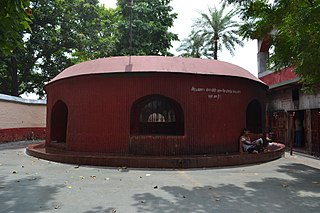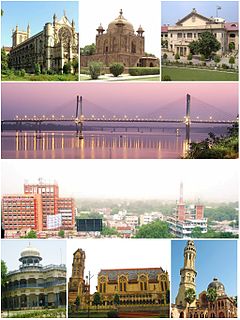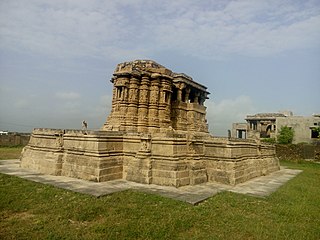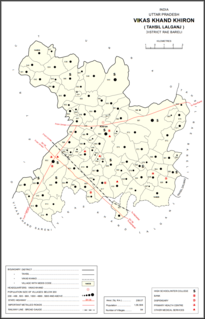
Arunachal Pradesh is a state in Northeastern India. It was formed from the erstwhile North-East Frontier Agency (NEFA) region, and became a state on 20 February 1987. It borders the states of Assam and Nagaland to the south. It shares international borders with Bhutan in the west, Myanmar in the east, and a disputed border with China in the north at the McMahon Line. Itanagar is the state capital of Arunachal Pradesh. Arunachal Pradesh is the largest of the Seven Sister States of Northeast India by area. Arunachal Pradesh shares a 1,129 km border with China's Tibet Autonomous Region.

The Gondi (Gōndi) or Gond or Koitur are a Dravidian ethno-linguistic group. They are one of the largest groups in India. They are spread over the states of Madhya Pradesh, Maharashtra, Chhattisgarh, Uttar Pradesh, Telangana, Andhra Pradesh, Bihar and Odisha. They are listed as a Scheduled Tribe for the purpose of India's system of reservation. The Gond have formed many kingdoms of historical significance.
Ram Janmabhoomi is the site that is hypothesized to be the birthplace of Rama, believed to be the seventh avatar of the Hindu deity Vishnu. The Ramayana states that the location of Rama's birthplace is on the banks of the Sarayu river in a city called "Ayodhya". Modern-day Ayodhya is in the north Indian state of Uttar Pradesh.

The Monpa or Mönpa is a major tribe of Arunachal Pradesh in northeastern India. The Tawang Monpas have a migration history from Changrelung. The Monpa are believed to be the only nomadic tribe in Northeast India - they are totally dependent on animals like sheep, cow, yak, goats and horses. The Monpa have a very close affinity with the Sharchops of Bhutan. Their languages are Tibeto-Burman languages written with the Tibetan alphabet.

Hastinapur is a city in the Meerut district in the Indian state of Uttar Pradesh. Hastinapura, described in Hindu texts such as the Mahabharata and the Puranas as the capital of the Kuru Kingdom, is also mentioned in ancient Jain texts. Hastinapur is located on the right bank of the Ganga river.

Vaisakhi, also pronounced Baisakhi, marks the first day of the month of Vaisakh and is traditionally celebrated annually on 13 April and sometimes 14 April as a celebration of spring harvest primarily in Northern India. Further, other Indian cultures and diaspora celebrate this festival too. Whilst it is culturally significant as a festival of harvest, some also consider Vaisakhi to be the legitimate date for the Indian Solar New Year. However, this is not a universally accepted belief as Hindus do not have a common New Year's Day, with some individuals considering the previous month of Chet as the New Year.

Agam Kuan is an ancient well and archaeological site in Patna, India. It is said to date back to the period of Mauryan emperor, Ashoka. Circular in shape, the well is lined with brick in the upper 13 metres (43 ft) and contains wooden rings in the remaining 19 metres (62 ft).
The Jains in India are the last direct representatives of the ancient Shramana tradition. People who practice Jainism, an ancient religion of the Indian subcontinent, are collectively referred to as Jains.

Palakollu is a city and the administrative headquarters of Palakollu Mandal in Narasapuram revenue division in West Godavari district of the Indian state of Andhra Pradesh. Palakollu is situated in Coastal Andhra region of the state. It occupies 4.685 square kilometres (1.809 sq mi). As of 2011 census, it has a population of about 61,284 and a Metro population of about 81,199. Palakollu Municipality merged five Grama panchayats of Seven village's on dated 7 January 2020. the Seven Village's population of 42,932 It around occupies 20.08 square kilometres (7.75 sq mi) and after merged palakollu municipality It around occupies 24.68 square kilometres (9.53 sq mi) with 35 election wards it is total population of 1,04,216 and making it the fourth most populous urban area in West Godavari District in Andhra Pradesh. It is a part of Eluru Urban Development Authority.

Malana is an ancient Indian village in the state of Himachal Pradesh. This solitary village in the Malana Nala, a side valley of the Parvati Valley to the north-east of Kullu Valley, is isolated from the rest of the world. The peaks of Chanderkhani and Deo Tibba shadow the village. It is situated on a remote plateau by the side of the torrential Malana river, at a height of 2,652 metres (8,701 ft) above sea level. Malana has its own lifestyle and social structure and people are strict in following their customs. Malana has been the subject of various documentaries, including Malana: Globalization of a Himalayan Village, and Malana, A Lost Identity. The existing speakers of the autochthonous language Kanashi, the traditional language of the inhabitants of Malana, number approximately 1700. According to the 1961 census, the language speakers were then 563, but today the population of Malana is at least three times as large as 40 years ago. The most common route to the village is by taxi or bus from Jhari. One stop prior to Malana. Roads till Malana Village trekking gate are developed.
Kotilingala is a Hindu pilgrimage site in Jagtial district of the Indian state of Telangana. It is situated in Velagatoor mandal of the district, on the Godavari river. It is located on the bank of the Godavari River, and has a traditional Shiva temple for Hindus, the Koteswara Siddeswara Temple.

Allahabad, officially known as Prayagraj, also known as Ilahabad, is a metropolis in the Indian state of Uttar Pradesh. It is the administrative headquarters of the Allahabad district—the most populous district in the state and 13th most populous district in India—and the Allahabad division. The city is the judicial capital of Uttar Pradesh with the Allahabad High Court being the highest judicial body in the state. As of 2011, Allahabad is the seventh most populous city in the state, thirteenth in Northern India and thirty-sixth in India, with an estimated population of 1.53 million in the city. In 2011 it was ranked the world's 40th fastest-growing city. Allahabad, in 2016, was also ranked the third most liveable urban agglomeration in the state and sixteenth in the country. Hindi is the most widely spoken language in the city.
Gurjar or Gujjar is an ethnic agricultural and pastoral community, spread mainly in India, Pakistan, Kashmir and Afghanistan, divided internally into various clan groups. Although traditionally they have been involved in agriculture, Gurjars are a large heterogeneous group that is internally differentiated in terms of religion, occupation, and socio-economic status. The historical role of Gurjars has been quite diverse in society, at one end they have been founder of several kingdoms, dynasties, and at the other end, they are also nomads with no land of their own.

Chaturbhuj Temple, dedicated to Vishnu, is situated at Orchha in Madhya Pradesh, India. The name Chaturbhuj is a combination of 'chatur' meaning "four" and 'bhuj' meaning "arms" which literally translates to "one who has four arms" and refers to Rama an Avatar of Vishnu. The temple has a complex multi-storied structural view which is a blend of temple, fort and palace architectural features.
A Chaupal, or chopal, is a community building or space in the rural areas of North India and Pakistan. It is the hub of community life in villages, especially for male inhabitants. In smaller villages, a chaupal can be a simple raised platform that is shaded by a large tree, typically a neem, banyan or pipal fig tree. In larger villages, the chaupal may be an elaborate structure that also doubles as a community guesthouse.

The Duladeo Temple is a Hindu temple in Khajuraho, Madhya Pradesh, India. The temple is dedicated to the god Shiva in the form of a linga, which is deified in the sanctum. 'Dulodeo' means "Holy Bridegroom". The temple is also known as "Kunwar Math". The temple faces east and is dated to 1000–1150 AD. It is the last of the temples built during the Chandela period. The temple is laid in the seven chariot plan (saptarata). The figurines carved in the temple have soft expressive features unlike other temples. The walls have a display of carved celestial dancers (apsara) in erotic postures and other figures.

The history of Uttar Pradesh the Northern Indian state, stretches back technically to its formation on 1 April 1937 as the North-Western Provinces of Agra and Awadh, but the region itself shows the presence of human habitation dating back to between 85,000 and 73,000 years ago. The region seems to have been domesticated as early as 6,000 BC.
Kaytha or Kayatha is a village and an archaeological site in the Ujjain district of Madhya Pradesh, India, in the Tarana tehsil, near the city of Ujjain, on the banks of Choti-Kali Sindh river. It is an archeologically and mythologically important village where several excavations have revealed cultures dating back to more than 4000 years, also said to be the birthplace of Chitragupt, a Hindu deity, in Southern scriptures and of Varahamihira, an ancient Indian astronomer. The archeologically important Kayatha culture was discovered by V. S. Wakankar in 1964

The Rama Lakshamana Temples or Samba Lakshamana Temples are the late 12th century twin Hindu temples in Baradia, a village in Okhamandal region of Devbhoomi Dwarka district, Gujarat, India. Baradia is about five km southeast of Dwarka. There are some temples near the coast within the limits of the village.

Deogaon is a village in Khiron block of Rae Bareli district, Uttar Pradesh, India. It is located 12 km from Lalganj, the tehsil headquarters. As of 2011, it has a population of 1,233 people, in 212 households. It has 1 primary school and a primary health centre and does not host a weekly haat or a permanent market. It serves as the headquarters of a nyaya panchayat which also includes 12 other villages.














